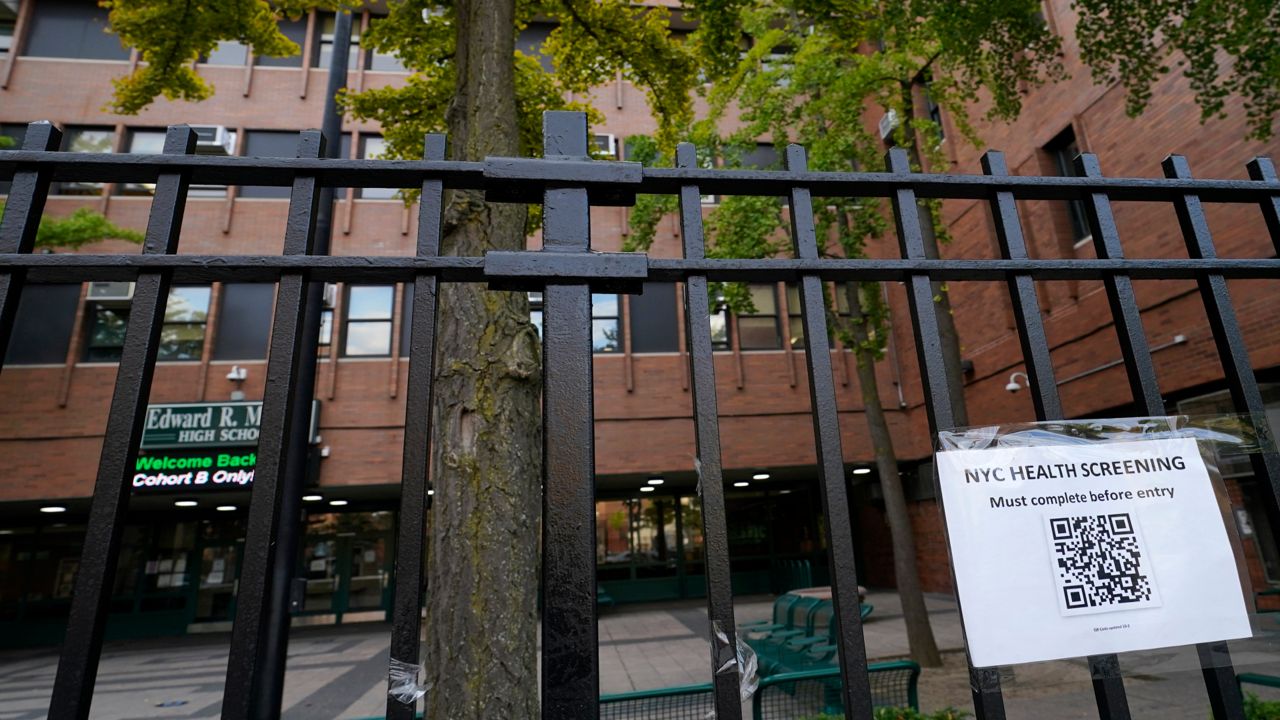NEW YORK — The city is preparing to shut down schools if the city’s seven-day coronavirus infection rate crosses the 3% threshold.
Currently, the percentage of people testing positive over a 7-day average is 2.6%. The rate has continued to climb over the past few weeks, crossing the 550 threshold of daily new COVID-19 infections for the last 11 days.
“If any day we see in the morning the indicators come out and have reached that level then we will move immediately,” Mayor Bill de Blasio said at his daily press briefing. “The next day, schools will be shut down, but there is still a chance to do something to avert that.”
Schools Chancellor Richard Carranza on Thursday night warned principals to prepare for a potential shift to full-remote learning as the city’s COVID-19 infection rate continues to rise.
“Out of an abundance of caution, and to keep our school communities safe, I am asking all schools to be prepared for a brief time of fully remote learning, system-wide. And while no decision has been made about a system-wide transition to remote learning, as every great school leader knows, we must be prepared for every scenario,” Carranza said in a letter to the principals at public schools.
Among Carranza’s recommendations:
- Distribute the school’s inventory of devices and LTE-enabled iPads to students that need them
- Communicate to teachers and students the expectations of full-remote learning and their schedules
If schools go completely remote, many parents, educators and students fear that the abrupt move will be as disruptive as it was at the end of the last school year. But the mayor emphasized that this time around the city is more prepared.
“Some people may tell you, ‘Oh, we’re about to go through the same thing we went through in March and in April,’” he said. “I don't think that is at all true, honestly. I think we have a challenge we’re facing right now, but we have a profound difference to begin with — experience. We’ve all been through this. We’ve proved that we can fight back and overcome it.”
The mayor also said the city was figuring out next steps should schools go completely remote, including what happens to essential workers and if school reopening looks different for various grade levels.
“If we get to a closure point, we’re then going to assess what we need to do to come back as quickly as possible and, at that point, we’ll look at a variety of options because we have something now we didn't have before — evidence of how schools will actually end up being in this and how things will end up working in this environment,” he said.
Coronavirus transmission in city schools has been quite low — just 0.18% of coronavirus tests conducted have come back positive — but it's possible indoor dining, which is seen as a far riskier activity, could remain open even as schools are forced to go remote because the decision to limit indoor dining rests with Gov. Andrew Cuomo.
Some prominent Democrats, including Mark Levine, the chair of the City Council's Health Committee, have called for indoor dining to be paused.
"If New York City closes schools but continues to allow indoor dining--which poses a far greater risk--then our priorities are backwards," Levine said in a statement.
Part of the public safety health guidelines he emphasized to try and combat the rising coronavirus numbers include avoiding travel and large indoor gatherings as the holidays approach. But as part of the city’s ramped up contact tracing efforts, if someone does return to the city after traveling, they’ll be provided a package that includes PPE, thermometer, pulse oximeter if they test positive for the virus, cleaning supplies, hand sanitizer and an at-home testing kit.
“What’s crucial here is the fact that this city will go the extra mile every time to help someone who needs to navigate this situation,” he said.
The mayor said he will stick to his 3% threshold for all tests citywide even though some communities have set higher benchmarks.
"This is a standard we set that was about keeping faith with everyone in all school communities,” he said.
Still, he said the city could rethink the metrics it will use to reopen schools if they do close.
"Now we have a lot more information about what's actually happening in the schools. A lot of valid questions, like what it might mean for younger kids versus older kids,” he said. “We're going to work through and talk to all the stakeholders about what the comeback strategy would look like and how quickly we could achieve it."
------
Did you know you can now watch, read and stay informed with NY1 wherever and whenever you want? Get the new Spectrum News app here.
------
This story includes reporting from Jillian Jorgensen.
------
Looking for an easy way to learn about the issues affecting New York City?
Listen to our "Off Topic/On Politics" podcast: Apple Podcasts | Google Play | Spotify | iHeartRadio | Stitcher | RSS
-----
Further Coronavirus Coverage
What to Do If You Test Positive for COVID-19
Who Will Get a Coronavirus Vaccine First — And Who Decides?
How Hospitals Protect Against the Spread of Coronavirus
Coronavirus Likely Spreads Without Symptoms
Coronavirus: The Fight to Breathe
Experts Say Masks Are Still a Must
The Race for a Coronavirus Vaccine
The U.S. May Face a Second Wave of Coronavirus Infections
Cuomo Granted Broad New Powers as New York Tackles Coronavirus
